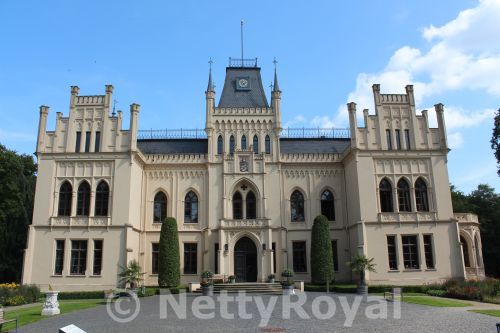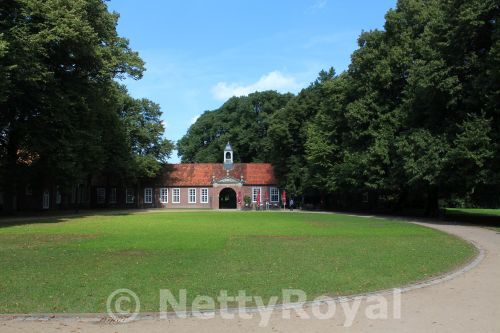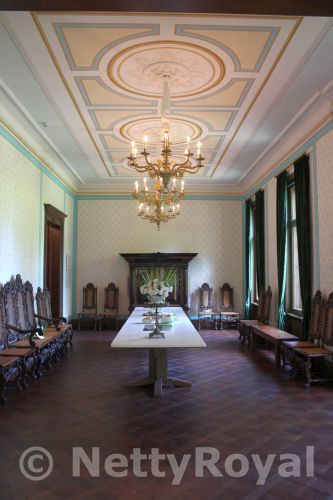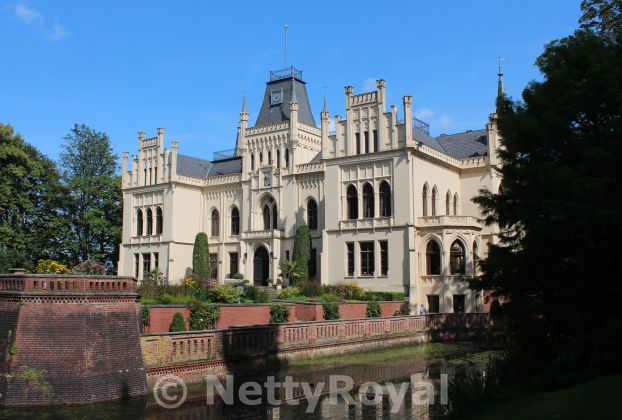In an earlier post I mentioned that there are no less than four castles in the small town of Leer, East Frisia, Germany. In December I traced the Haneburg already. On Friday I did find the other three. Unfortunately the Harderwykenburg, situated near the centre, is hidden behind trees and fences. And I decided to try another time if I can get a bit closer (although I doubt it). The only one of the four that can be visited is the Evenburg Castle.


1642 Erhard Freiherr von Ehrentreuter had the first Evenburg build, a moat castle on an island. It was a two-storey brick house in the style of the Dutch classicism. In 1690 it came through marriage into the possession of the Counts von Wedel. Georg Wilhelm von Wedel (1641-1717) – made a count by King Christian V of Denmark in 1684 – had married Marie von Ehrentreuter in 1665. During this time the present gate building was erected. However in the 19th century the Counts von Wedel found the building too small. Carl Georg Count von Wedel asked the architect Richard Stüve to enlarge and reconstruct the building. The architect notes that the existing castle was in a state of disrepair and he had almost the whole old castle taken down, apart from the enclosure walls, a few walls inside, the basement and the blue stone marble floor.
Stüve built the new castle in Neo-Gothic style. It only took two years before it was finished. More buildings in the park followed, including some glasshouses. Around 1926 the Wedel family changed the main family seat to Gödens Castle, where the family lives today. Maintaining the Evenburg castle afterwards became too expensive. Despite of having been damaged in April 1945, the building after World War II was used as a hospital, as a residence for refugees, later as a boarding school. After 1968 the building was no longer in use and falls into disrepair. In 1975 the borough of Leer bought the castle and 110 hectares of land. A first renovation follows, another one 2004-2014.
Inside the castle unfortunately not much history, although in and around the building you can find information boards (in German) telling all about the house, the gardens and its owners. In one of the corridors I even found a quite well updated family tree of the family from probably 2012. The floors, ceilings and walls in the hall, as well as the doors, show lovely details. What I however did like that – as we were there on a nice and sunny day – the windows were open, so you could look at the park. And you were even allowed on the small balcony above the main entrance. A sheet with a bit of information can be borrowed in the small castle shop, at least in Dutch, presumably also in English.



Around the castle one finds a lovely English landscape park. Erhard Friedrich Count von Wedel had a baroque park created in the early 18th century, with glasshouses where one could find oranges, pomegranates, figs ad many other exotic plants. It was turned into a landscape park late 18th/early 19th century. With the new castle also the gardens were renewed, with among others bridges and extra buildings.
In and around the castle concerts and lectures take place, you can get married in the building, there are some small exhibitions. In the gate house there is a nice café where you can have a drink, and eat some cake or even Flammkuchen. On the other side of the street is the Patronatskirche, the church where you can find the graves of the old Counts von Wedel. The vault was renovated 2014-2015. Unfortunately it can only be visited during a tour.
